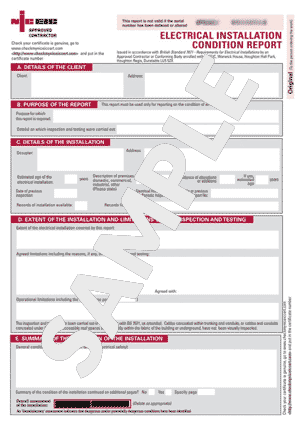From April 1st 2021 ALL private tenancies, new and existing, must have a current and valid Electrical Installation Condition Report.
Mandatory electrical safety inspections, Electrical Installation Condition Report for private landlords were introduced on the 1st April 2020. The new regulations: ‘The Electrical Safety Standards in the Private Rented Sector (England) Regulations 2020‘ require regular safety checks to be carried out and the reports made available in all new tenancies after 1st July 2020.
We’ve compiled the answers to the most frequently asked questions we get about the EICR (or landlord electrical safety certificate), so if you want to know if you need one; what’s involved; the penalties for non-compliance; and much more, read on.
CALL US NOW to BOOK YOUR EICR – 0208 9975 692
If your EICR grades your installation is ‘Unsatisfactory’ the areas of concern will be clearly categorised as follows:
If you have any C1 and C2 observations they have to be rectified before the installation can be described as ‘Satisfactory’ and the EICR essentially passed.
Anything marked as FI is an area that is not covered by the EICR but the electrician observed something that requires further investigation.
You will need to deal with C1, C2 and FI faults to be compliant with electrical safety regulations. It is good practice to rectify all faults highlighted on the report. It’s important to note that you do not have to use the same electrical contractor to complete any remedial action. You also don’t need to completely re-test the whole installation after the repairs have been carried out. Be sure to obtain a certificate for each part of your installation that has been repaired or replaced.
Category C3 is something that has been identified as non-compliant with the latest regulations but is not dangerous.
From 1st April 2021, every property rented to private tenants must have an EICR certificate. This includes tenants under Assured Shorthold Tenancy, Licence to Occupy, and a Periodic Tenancy. A Periodic Tenancy is where a rental agreement has expired and neither landlord or tenant has served written notice on each other to end the tenancy and it ‘rolls-over’ into a continuation of the original agreement.
You do not need an EICR if you are:
An EICR – Electrical Installation Condition Report (also referred to as a Periodic Inspection Report or Landlord Certificate) is like an electrical MOT for your house. A qualified electrician will inspect and test your electrical circuits and your fixed electrical equipment and provide you with a report that identifies any defects, damage, deterioration or conditions that are, or may become, dangerous. The EICR categorises and rates the findings and makes recommendations for repairs and improvements.
An EICR is required every 5 years or until a new tenancy begins, whichever comes first. See also the FAQ “Is a Periodic Tenancy a New Tenancy?”
If you have a swimming pool it should be inspected and tested every year.
Whilst an EICR is not required for home owners it is recommended that one is carried out at least every 10 years.
Only registered electricians should carry out an EICR. They must be able to prove competency by holding a Level 3 Award in Periodic Inspection, Testing and Certification of Electrical Installations (EICR)
It is the landlords responsibility to organise an EICR at the start of each new tenancy or at the end of the 5 year term. The full report must be provided to the tenant within 28 days of completion and to the local authority, if requested, within 7 days.
A qualified electrician carrying out an EICR will inspect and test the electrical circuits and installations within a building are correctly installed, safe and well maintained. That means identifying overloaded systems, risks of electric shock, fire hazards, defective electrical works, lack of correct earthing.
The following will be tested:
A typical EICR inspection will generally take 3-4 hours for a modern 3 bedroom house with a kitchen, bathroom and living room. The time taken is dependent upon the size of the property, the number of circuits and the number of issues found.
Each circuit within the system does require a short period when the power is turned off during the EICR inspection however the majority of the testing is carried out whilst the electricity is on. For the most part the electrician can plan the outages around your activities. Domestic circuits are generally – downstairs sockets, upstairs sockets, downstairs lights, upstairs lights etc.
Yes there is. From April 1st 2021 not having a current and valid EICR would mean you are in breach of the ‘Electrical Safety Standards in the Private Rented Sector (England) Regulations 2020’ and would leave you exposed to a fine of up to £30,000 issued by the local authority. This includes failure to carry out repairs or remedial work identified and required to be fixed by the EICR Inspection.
It depends upon the current tenancy agreement but it can be determined by the answer to the following question:
Does the current tenancy agreement state that at the end of the fixed term the contract will become Periodic ?
Note: A Periodic Tenancy is where a rental agreement has expired and neither landlord or tenant has served written notice on each other to end the tenancy and it ‘rolls-over’ into a continuation of the original agreement.
